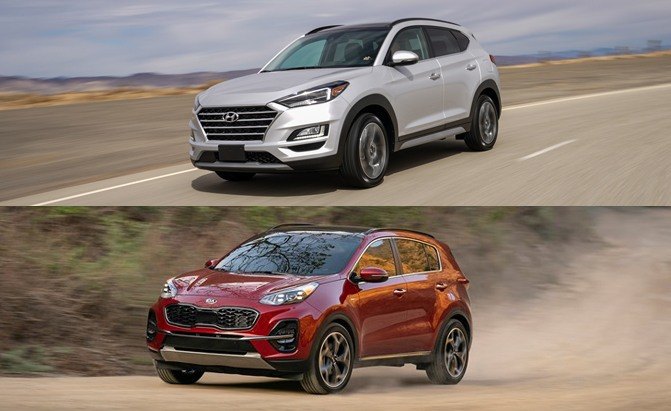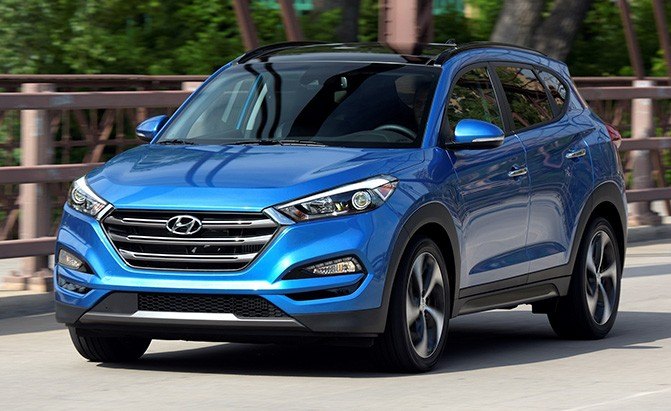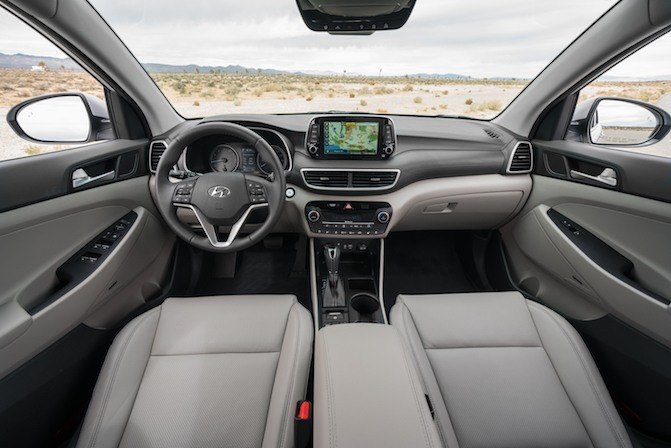AUTONEWS
 Hyundai Tucson vs Kia Sportage
Hyundai Tucson vs Kia Sportage
Hyundai and Kia share a close relationship, with Hyundai having acquired a 51% stake in Kia in 1998 and serving the Kia's largest single stakeholder today.
The companies share platforms, engines and other parts for their vehicles, often making the two brand products feel very similar.
Two fairly similar vehicles offered by the Hyundai Tucson and Kia Sportage brands - they share a lot of parts and compete in the same segment. These two products are similarly sized and priced and therefore may be cross-shopped by consumers in the market for a new family hauler.
In this post, we'll explain the key differences between the Hyundai Tucson and Kia Sportage, hopefully leaving you armed with enough knowledge to make a confident buying decision at the dealership.

Body Styles / Design
Hyundai Tucson: The Tucson was updated for the 2018 model year and therefore looks fairly recent and modern, with tidy styling, large optional alloy wheels and available LED daytime running lights and taillights. A new grille was part of the updates, and the new look brought it in line with the rest of Hyundai's SUV lineup. It's certainly nothing exciting, but that's what most buyers in this segment want. Its looks are quite conventional, but it's definitely not ugly or controversial.

Kia Sportage: The Sportage has not been updated in a while, rocking the same looks that it did when it was introduced in 2015. Some shoppers might prefer the more unique look of the Sportage, though, with Kia's 'Tiger Nose' grille and the narrow greenhouse making the Sportage appear more upmarket than the Tucson. Some shoppers, however, might not like the Sportage's upright stance, feeling that there is something odd about the headlight placement and large quad foglights housing. The high up placement of the headlights in relation to the grille gives the Sportage a bit of a surprised look.

Hyundai Tucson: The Tucson is a compact two-row crossover with seating for five. It has a total interior volume of 133 cu-ft. It also has a full charge of 31 cu-ft with the rear seats folded up, which grows to 61.9 cu-ft when you fold them down. Hyundai also claims front headroom of 39.6 inches and front leg room of 41.5 inches, while rear headroom sits at 39.2 inches and rear legroom at 38.2 inches.
 Kia Sportage: The Sportage is also a compact two-row crossover with seating for five. It has a total interior volume of 129.3 cu-ft and a cargo volume of 30.7 cu-ft with the second row up, and 60.1 cu-ft with the second row folded down. Kia claims front headroom of 39.3 inches and second row headroom of 39.1 inches. Front legroom comes in at 41.5 inches and middle legroom is 38.2 inches.
Kia Sportage: The Sportage is also a compact two-row crossover with seating for five. It has a total interior volume of 129.3 cu-ft and a cargo volume of 30.7 cu-ft with the second row up, and 60.1 cu-ft with the second row folded down. Kia claims front headroom of 39.3 inches and second row headroom of 39.1 inches. Front legroom comes in at 41.5 inches and middle legroom is 38.2 inches.
Bottom Line: The Sportage and Tuscon have identical interior dimensions and cargo capacity, although the Tucson appears to have slightly better packaging. The differences here are pretty small, so it would be best to see both cars in person and see which is more practical for your specific needs. Do not forget to bring any items you might need to drive with on a regular basis like your hockey bag and kid's car seats or strollers to see if they fit.

Hyundai Tucson: The Hyundai Tucson is offered with two engines: a 161-hp 2.0-liter four-cylinder or a 181-hp 2.4-liter four-cylinder. Both engines are paired with a standard six-speed automatic transmission and all-wheel drive is available as an option.
The 2.0-liter front-wheel-drive models get 23 MPG city and 30 MPG highway for a combined rating of 26 MPG, while 2.0-liter AWD models get 22 MPG city and 25 MPG highway for a combined rating of 23 MPG. The 2.4-liter front-drive models get 22 MPG city and 28 MPG highway for a combined rating of 25 MPG, while 2.4-liter AWD models get 21 MPG city and 26 MPG highway for a combined rating of 23 MPG.

The 2.4-liter front-drive models get 22 MPG city and 29 MPG highway for a combined rating of 25 MPG. Those figures fall to 21 MPG city, 25 MPG highway and 23 MPG combined for 2.4-liter AWD models.
Sportage 2.0-liter turbos with front-wheel drive are rated at 21 MPG city and 26 MPG highway for a combined effort of 23 MPG. Adding AWD will see those numbers drop to 20 MPG city, 23 MPG highway and 21 MPG combined.
Bottom Line: The Tucson is offered with a lesser base engine, while the Sportage offers the Tucson's optional 2.4-liter engine as standard. The Sportage also has 240-hp 2.0-liter engine, which is a pretty high power output for this segment. We'd say the Sportage is the winner in the powertrain department.

Hyundai Tucson: We drove the Hyundai Tucson back in 2017 when it had a different powertrain consisting of a 1.6-liter turbo and a seven-speed DCT transmission. The DCT is no longer offered, which is a good thing because we have experienced some juddering and unrefined shifts from that transmission.
The chassis has not changed much since then, however, and we said that it was "comfortable, predictable, and rides smoothly over rough roads while still not feeling terrible in corners." We also said the crossover felt "a lot more buttoned- down and composed than the (Honda) CR-V, which can feel sloppy at times. "
Kia Sportage: We drove the Sportage with the 2.4-liter four-cylinder engine and said the "engine power is plentiful and rightfully stout than most of the Sportage's competitors," although we noted that it was not as peppy as some turbocharged rivals at the time. We also said the crossover "drives smoothly with well-controlled rebound over bumps while not jostling passengers. And the cabin remains fairly quiet, even on grooved concrete. "

Hyundai Tucson: The Tucson offers a 7-inch color touchscreen display as standard, which comes with Apple CarPlay and Android Auto, along with a six-speaker audio system. The crossover also comes with standard safety features like forward collision-avoidance assist, driver warning warning, lane keep assist, and more. Blind spot monitoring, adaptive cruise control with stop-and-go, surround view monitor, rear-cross traffic alert, forward collision avoidance assist with pedestrian detection, high beam assist, a hands-free liftgate, ventilated front seats, and heated rear seats , an 8-inch touchscreen, wireless phone charging, rain sensing wipers, and second-row USB ports are also available.
 Kia Sportage: The Sportage offers a 3.5-inch TFT display in the gauge cluster as standard, while a 4.2-inch display is offered on range-topping SX Turbo models. A six-speaker audio system is also standard, but drivers can also upgrade to a Harman / Kardon audio system. The 5-inch touchscreen is standard, but drivers can upgrade to a 7 or 8-inch touchscreen. Android Auto and Apple CarPlay are available. There are minimal standard active safety features, although things like autonomous emergency braking, lane change assist, blind spot detection, rear-cross traffic alert, and lane departure warning are available as options. Also available are ventilated front seats.
Kia Sportage: The Sportage offers a 3.5-inch TFT display in the gauge cluster as standard, while a 4.2-inch display is offered on range-topping SX Turbo models. A six-speaker audio system is also standard, but drivers can also upgrade to a Harman / Kardon audio system. The 5-inch touchscreen is standard, but drivers can upgrade to a 7 or 8-inch touchscreen. Android Auto and Apple CarPlay are available. There are minimal standard active safety features, although things like autonomous emergency braking, lane change assist, blind spot detection, rear-cross traffic alert, and lane departure warning are available as options. Also available are ventilated front seats.

Hyundai Tucson: The Tucson starts at $ 23,200 for the base model. The 2.4-liter FWD starts at $ 25,600, while the vehicle's pricing tops out at $ 32,950 for the Tucson Ultimate with the 2.4-liter and AWD. The cheapest AWD model, the Tucson SE with the 2.0-liter engine, starts at $ 24,600.
Kia Sportage: The Sportage starts at $ 23,750 in the United States for the base model. The 2.0-liter Turbo FWD starts at $ 33,100, while the vehicle tops out at $ 34,600 for the SX Turbo Sportage with AWD. The cheapest AWD model, the Sportage LX AWD, starts at $ 25,250.
Bottom Line: The Tucson is a bit more affordable than the Sportage, especially when both crossovers are in higher trim levels, although both are good value for money, in our opinion. The best value proposition here is probably the 2.4-liter Tuscon with AWD, which nets you superior technology to the Sportage and a similar powertrain for a little less cash.
 Hyundai and Kia are both brands that are known for their good value. Both the Tucson and the Sportage are solid competitors in the compact crossover segment, and while some other crossovers may offer superior driving dynamics, these two are great value for money and should also be fairly reliable, too.
Hyundai and Kia are both brands that are known for their good value. Both the Tucson and the Sportage are solid competitors in the compact crossover segment, and while some other crossovers may offer superior driving dynamics, these two are great value for money and should also be fairly reliable, too.If you value up-to-date technology, the Tucson is the better pick of these two for you - it has much better features and more available amenities. If you want something with a bit more power but do not care so much about tech, the Sportage is probably better suited to your needs. By Sam McEachern

Nenhum comentário:
Postar um comentário